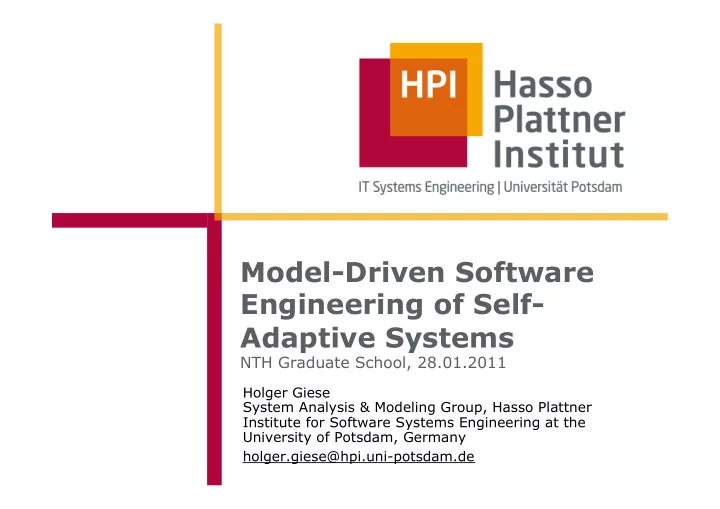

Model-Driven Software Engineering of Self- Adaptive Systems NTH Graduate School, 28.01.2011 Holger Giese System Analysis & Modeling Group, Hasso Plattner Institute for Software Systems Engineering at the University of Potsdam, Germany holger.giese@hpi.uni-potsdam.de
Outline 2 I Motivation – Why self-adaptiveness? II Foundations - What is self-adaptiveness? III Construction – How to build them? IV Quality Assurance – How to ensure their quality? V Conclusion 16.02.2010 | Holger Giese | Model-Driven Software Engineering of Self-Adaptive Systems
I Motivation: Software Evolution & Aging 3 Software Evolution [Lehman&Belady1985,Lehman1997]: ! Programs always include explicit and implicit assumptions about the real world domain Environment ! The real world domain and the program (and its explicit and implicit assumptions) must be maintained Original compatible and valid with one another ! Developing software is a complex feedback system abstract Validation: Describes Developer the model the original Two types of software aging [Parnas1994]: for the Software purpose ! Lack of Movement: Aging caused by the failure of the correct? (Model) product’s owners to modify it to meet changing needs. ! Ignorant Surgery: Aging caused as a result of changes runs on that are made. Platform ! This “one-two punch” can lead to rapid decline in the value of a software product. 16.02.2010 | Holger Giese | Model-Driven Software Engineering of Self-Adaptive Systems
I Motivation: Software Complexity & Administration 4 Autonomic Computing [AC2001]: ! Evolution via automation also produces complexity as an unavoidable byproduct (especially true for IT Environment systems: incredible progress in speed, storage and communication; extreme growth software with >30 million loc and > 4,000 programmers) Original ! In fact, the growing complexity of the I/T infrastructure abstract threatens to undermine the very benefits information Admin technology aims to provide, because systems cannot be managed any more. Software Proposed solution: (Model) ! make things simpler for administrators and users of I/T runs on by automating its management (Paradoxically, it seems we need to create even more complex systems). Platform ! Inspiration is the massively complex systems of the human body: the autonomic nervous system . 16.02.2010 | Holger Giese | Model-Driven Software Engineering of Self-Adaptive Systems
I Motivation: Software Landscapes vs. Applications 5 Automotive Industrial automation Sensor Networks Environment Original Original Original Mobile Devices Transportation abstract IT Systems Who? ! Characteristics: large-scale, heterogeneous, distributed, Software Software Software ad hoc evolution, no central authority (Model) (Model) (Model) ! May include: Server backends, embedded subsystems, runs on wireless ad hoc networks, mobile devices, … Platform Platform Platform The software must resolve adaption needs due to changes in the context and platform itself to be able to work at all 16.02.2010 | Holger Giese | Model-Driven Software Engineering of Self-Adaptive Systems
I Motivation: Future Software Landscape Example 6 http://www.railcab.de/ Test track Test shuttle A shuttle system that builds convoys to optimize the energy consumption 16.02.2010 | Holger Giese | Model-Driven Software Engineering of Self-Adaptive Systems
II Foundations: Self-Adaptiveness 7 Environment Original The software Original Original itself! What do we need? abstract Who? Software Software Software (Model) (Model) (Model) runs on Platform Platform Platform [Salehie&Tahvildari2009] 16.02.2010 | Holger Giese | Model-Driven Software Engineering of Self-Adaptive Systems
II Foundations: Adaptation Loop 8 [Brun+2009] 16.02.2010 | Holger Giese | Model-Driven Software Engineering of Self-Adaptive Systems
II Foundations: Architecture & Self 9 Internal Approach External Approach [Salehie&Tahvildari2009] 16.02.2010 | Holger Giese | Model-Driven Software Engineering of Self-Adaptive Systems
II Foundations: Models and Adaptation 10 Adapt “without” models: ! Still explicit or implicit design-time models are used to guide adaptation processes ! Limitation: covers only changes covered by one model of the software’ + context (potentially including some parameters or structural changes that can be observed) Adapt with runtime models: ! Explicit runtime models are used to guide adaptation processes ! Limitation: covers only changes captured by the runtime models ( multiple !); requires correct adjustment of them based on the observations 16.02.2010 | Holger Giese | Model-Driven Software Engineering of Self-Adaptive Systems
II Foundations: Top-Down Architecture Reference Architecture for Self-Management: 11 ! Layers for different purposes ! Decoupling of the layers in time [Kramer&Magee2007] 16.02.2010 | Holger Giese | Model-Driven Software Engineering of Self-Adaptive Systems
II Foundations: Bottom-Up Architecture [Dressler2007] 12 Self-organization is a process in which structure and functionality at the global level of a system emerge solely from numerous interactions among the lower-level components. Characteristics: ! No central control ! Emerging structure ! Resulting complexity ! High scalability Emergence is an apparently meaningful collaboration of components (individuals) resulting in capabilities of the overall system (far) beyond the capabilities of the single components. 16.02.2010 | Holger Giese | Model-Driven Software Engineering of Self-Adaptive Systems
II Foundations: Subject of Adaptation 13 Adaptation Parameter Structure Behavior (implicit) Compositional Infinite Finite Reconfiguration Adaptation domain domain Dynamic Static set creation of entities and deletion But how can we systematically build the software for such systems (construction)? 16.02.2010 | Holger Giese | Model-Driven Software Engineering of Self-Adaptive Systems
III Construction: Control Loop Development time: 14 || || Adaption Function Context Runtime: ! | | ! Challenges: """"""""""""""""""" ! | | ! """"""""""""""""""" ! | | ! Adaption """"""""""""""""""" ! | | ! (1) How to design the """"""""""""""""""" ! | | ! """"""""""""""""""" ! | | ! adaptation algo.? """"""""""""""""""" ! | | ! """"""""""""""""""" (2) How to architect ! | | ! """"""""""""""""""" ! | | ! Function Context """"""""""""""""""" systems with control ! | | ! """"""""""""""""""" ! | | ! """"""""""""""""""" ! | | ! loops? """"""""""""""""""" (3) How to develop the Legend: necessary elements ! | | ! """""""""""""""" Software- ! | | ! """""""""""""""" Modell System ! | | ! """""""""""""""" system ! | | ! """""""""""""""" of the loop? ! | | ! """""""""""""""" 16.02.2010 | Holger Giese | Model-Driven Software Engineering of Self-Adaptive Systems
Recommend
More recommend